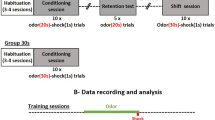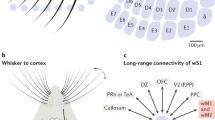Abstract
When rodents engage in the exploration of novel stimuli, breathing occurs at an accelerated rate that is synchronous with whisking. We review the recently observed relationships between breathing and the sensations of smell and vibrissa-based touch. We consider the hypothesis that the breathing rhythm serves not only as a motor drive signal, but also as a common clock that binds these two senses into a common percept. This possibility may be extended to include taste through the coordination of licking with breathing. Here we evaluate the status of experimental evidence that pertains to this hypothesis.
This is a preview of subscription content, access via your institution
Access options
Subscribe to this journal
Receive 12 print issues and online access
$209.00 per year
only $17.42 per issue
Buy this article
- Purchase on Springer Link
- Instant access to full article PDF
Prices may be subject to local taxes which are calculated during checkout




Similar content being viewed by others
References
Feldman, J.L. & Del Negro, C.A. Looking for inspiration: new perspectives on respiratory rhythm. Nat. Rev. Neurosci. 7, 232–242 (2006).
Garcia, A.J., Zanella, S., Koch, H., Doi, A. & Ramirez, J.M. Networks within networks: the neuronal control of breathing. Prog. Brain Res. 188, 31–50 (2011).
Tan, W., Pagliardini, S., Yang, P., Janczewski, W.A. & Feldman, J.L. Projections of preBötzinger complex neurons in adult rats. J. Comp. Neurol. 518, 1862–1878 (2010).
Moore, J.D. et al. Hierarchy of orofacial rhythms revealed through whisking and breathing. Nature 497, 205–210 (2013).
Travers, J.B., Dinardo, L.A. & Karimnamazi, H. Motor and premotor mechanisms of licking. Neurosci. Biobehav. Rev. 21, 631–647 (1997).
Koizumi, H. et al. Functional imaging, spatial reconstruction, and biophysical analysis of a respiratory motor circuit isolated in vitro. J. Neurosci. 28, 2353–2365 (2008).
McFarland, D.H. & Lund, J.P. An investigation of the coupling between respiration, mastication, and swallowing in the awake rabbit. J. Neurophysiol. 69, 95–108 (1993).
Sherrey, J.H. & Megirian, D. State dependence of upper airway respiratory motoneurons: functions of the cricothyroid and nasolabial muscles of the unanesthetized rat. Electroencephalogr. Clin. Neurophysiol. 43, 218–228 (1977).
Singer, W. & Gray, C.M. Visual feature integration and the temporal correlation hypothesis. Annu. Rev. Neurosci. 18, 555–586 (1995).
Varela, F., Lachaux, J.-P., Rodriguez, E. & Martinerie, J. The brainweb: phase synchronization and large-scale integration. Nat. Rev. Neurosci. 2, 229–239 (2001).
Adrian, E.D. Olfactory reactions in the brain of the hedgehog. J. Physiol. (Lond.) 100, 459–473 (1942).
Cury, K.M. & Uchida, N. Robust odor coding via inhalation-coupled transient activity in the mammalian olfactory bulb. Neuron 68, 570–585 (2010).
Uchida, N. & Mainen, Z.F. Speed and accuracy of olfactory discrimination in the rat. Nat. Neurosci. 6, 1224–1229 (2003).
Sobel, E.C. & Tank, D.W. Timing of odor stimulation does not alter patterning of olfactory bulb unit activity in freely breathing rats. J. Neurophysiol. 69, 1331–1337 (1993).
Wallois, F., Macron, J.M., Jounieaux, V. & Duron, B. Trigeminal nasal receptors related to respiration and to various stimuli in rats. Respir. Physiol. 85, 111–125 (1991).
Grosmaitre, X., Santarelli, L.C., Tan, J., Luo, M. & Ma, M. Dual functions of mammalian olfactory sensory neurons as odor detectors and mechanical sensors. Nat. Neurosci. 10, 348–354 (2007).
Shusterman, R., Smear, M.C., Koulakov, A.A. & Rinberg, D. Precise olfactory responses tile the sniff cycle. Nat. Neurosci. 14, 1039–1044 (2011).
Dhawale, A.K., Hagiwara, A., Bhalla, U.S., Murthy, V.N. & Albeanu, D.F. Non-redundant odor coding by sister mitral cells revealed by light addressable glomeruli in the mouse. Nat. Neurosci. 13, 1404–1412 (2010).
Reisert, J. & Zhao, H. Response kinetics of olfactory receptor neurons and the implications in olfactory coding. J. Gen. Physiol. 138, 303–310 (2011).
Carey, R.M. & Wachowiak, M. Effect of sniffing on the temporal structure of mitral/tufted cell output from the olfactory bulb. J. Neurosci. 31, 10615–10626 (2011).
Smear, M., Shusterman, R., O'Connor, R., Bozza, T. & Rinberg, D. Perception of sniff phase in mouse olfaction. Nature 479, 397–400 (2011).
Miura, K., Mainen, Z.F. & Uchida, N. Odor representation in olfactory cortex: distributed rate coding and decorrelated population activity. Neuron 74, 1087–1098 (2012).
Curtis, J.C. & Kleinfeld, D. Phase-to-rate transformations encode touch in cortical neurons of a scanning sensorimotor system. Nat. Neurosci. 12, 492–501 (2009).
O'Connor, D.H., Peron, S.P., Huber, D. & Svoboda, K. Neural activity in barrel cortex underlying vibrissa-based object localization in mice. Neuron 67, 1048–1061 (2010).
O'Connor, D.H. et al. Vibrissa-based object localization in head-fixed mice. J. Neurosci. 30, 1947–1967 (2010).
Mehta, S.B., Whitmer, D., Figueroa, R., Williams, B.A. & Kleinfeld, D. Active spatial perception in the vibrissa scanning sensorimotor system. PLoS Biol. 5, e15 (2007).
Knutsen, P.M., Pietr, M. & Ahissar, E. Haptic object localization in the vibrissal system: behavior and performance. J. Neurosci. 26, 8451–8464 (2006).
Kleinfeld, D. & Deschênes, M. Neuronal basis for object location in the vibrissa scanning sensorimotor system. Neuron 72, 455–468 (2011).
Szwed, M., Bagdasarian, K. & Ahissar, E. Coding of vibrissal active touch. Neuron 40, 621–630 (2003).
Hires, S.A., Pammer, L., Svoboda, K. & Golomb, D. Tapered whiskers are required for active tactile sensation. Elife 2, e01350 (2013).
Fee, M.S., Mitra, P.P. & Kleinfeld, D. Central versus peripheral determinates of patterned spike activity in rat vibrissa cortex during whisking. J. Neurophysiol. 78, 1144–1149 (1997).
Poulet, J.F. & Petersen, C.C. Internal brain state regulates membrane potential synchrony in barrel cortex of behaving mice. Nature 454, 881–885 (2008).
Welker, W.I. Analysis of sniffing of the albino rat. Behav. 22, 223–244 (1964).
Ranade, S., Hangya, B. & Kepecs, A. Multiple modes of phase locking between sniffing and whisking during active exploration. J. Neurosci. 33, 8250–8256 (2013).
Ketchum, K.L. & Haberly, L.B. Membrane currents evoked by afferent fiber stimulation in rat piriform cortex. I. Current source-density analysis. J. Neurophysiol. 69, 248–260 (1993).
Vaidya, S.P. & Johnston, D. Temporal synchrony and gamma-to-theta power conversion in the dendrites of CA1 pyramidal neurons. Nat. Neurosci. 16, 1812–1820 (2013).
Haider, B., Duque, A., Hasenstaub, A.R. & McCormick, D.A. Neocortical network activity in vivo is generated through a dynamic balance of excitation and inhibition. J. Neurosci. 26, 4535–4545 (2006).
Salinas, E. & Sejnowski, T.J. Impact of correlated synaptic input on output firing rate and variability in simple neuronal models. J. Neurosci. 20, 6193–6209 (2000).
O'Connor, D.H. et al. Neural coding during active somatosensation revealed using illusory touch. Nat. Neurosci. 16, 958–965 (2013).
Rolls, E.T. The rules of formation of the olfactory representations found in the orbitofrontal cortex olfacory ares in primates. Chem. Senses 26, 595–604 (2001).
Johnston, J.B. Further contributions to the study of the evolution of the forebrain. J. Comp. Neurol. 35, 337–481 (1923).
McDonald, A.J. Cortical pathways to the mammalian amygdala. Prog. Neurobiol. 55, 257–332 (1998).
Ray, J.P. & Price, J.L. The organization of the thalamocortical connections of the mediodorsal thalamic nucleus in the rat, related to the ventral forebrain-prefrontal cortex topography. J. Comp. Neurol. 323, 167–197 (1992).
Rousseaux, M., Muller, P., Gahide, I., Mottin, Y. & Romon, M. Disorders of smell, taste, and food intake in a patient with a dorsomedial thalamic infarct. Stroke 27, 2328–2330 (1996).
Berg, R.W., Whitmer, D. & Kleinfeld, D. Exploratory whisking by rat is not phase-locked to the hippocampal theta rhythm. J. Neurosci. 26, 6518–6522 (2006).
Margrie, T.W. & Schaefer, A.T. Theta oscillation coupled spike latencies yield computational vigour in a mammalian sensory system. J. Physiol. (Lond.) 546, 363–374 (2003).
Macrides, F., Eichenbaum, H.B. & Forbes, W.B. Temporal relationship between sniffing and the limbic theta rhythm during odor discrimination reversal learning. J. Neurosci. 2, 1705–1717 (1982).
Nakamura, Y. & Katakura, N. Generation of masticatory rhythm in the brainstem. Neurosci. Res. 23, 1–19 (1995).
Takatoh, J. et al. New modules are added to vibrissal premotor circuitry with the emergence of exploratory whisking. Neuron 77, 346–360 (2013).
Travers, J.B., Herman, K. & Travers, S.P. Suppression of 3rd ventricular NPY-elicited feeding following medullary reticular formation infusion of muscimol. Behav. Neurosci. 124, 225–233 (2010).
Acknowledgements
This Perspective is dedicated to the late John C. Curtis. We thank W. Denk, B. Friedman, J.S. Isaacson, S. Jacobson, H.J. Karten, T. Komiyama, D. Rinberg and K. Svoboda for discussions, and K. Miura, D. Rinberg and N. Uchida for supplying data sets. This perspective was conceived at a 2013 Janelia Farms Research Center meeting and the subsequent work was supported by grants from the National Institute of Mental Health (MH085499), the National Institute of Neurological Disorders and Stroke (NS058668 and NS077986), the Canadian Institutes of Health Research (grant MT-5877), and the US-Israeli Binational Foundation (2011432).
Author information
Authors and Affiliations
Corresponding author
Ethics declarations
Competing interests
The authors declare no competing financial interests.
Rights and permissions
About this article
Cite this article
Kleinfeld, D., Deschênes, M., Wang, F. et al. More than a rhythm of life: breathing as a binder of orofacial sensation. Nat Neurosci 17, 647–651 (2014). https://doi.org/10.1038/nn.3693
Received:
Accepted:
Published:
Issue Date:
DOI: https://doi.org/10.1038/nn.3693
This article is cited by
-
Basal ganglia–spinal cord pathway that commands locomotor gait asymmetries in mice
Nature Neuroscience (2024)
-
Breath-holding as model for the evaluation of EEG signal during respiratory distress
European Journal of Applied Physiology (2024)
-
Parabrachial tachykinin1-expressing neurons involved in state-dependent breathing control
Nature Communications (2023)
-
The functional anatomy of elephant trunk whiskers
Communications Biology (2023)
-
The PROUST hypothesis: the embodiment of olfactory cognition
Animal Cognition (2023)



